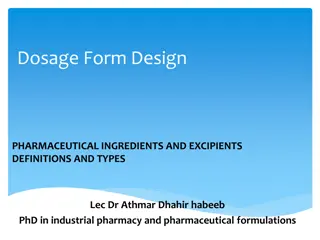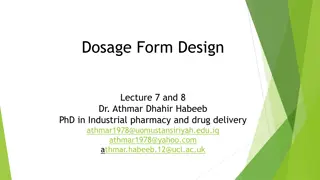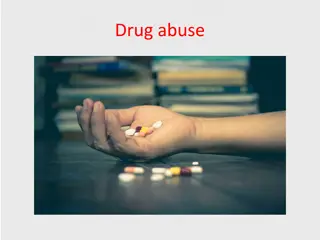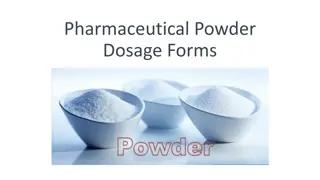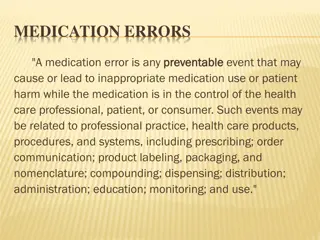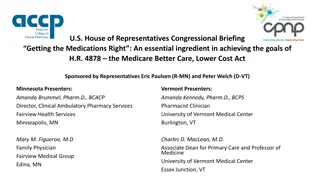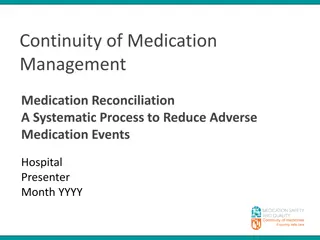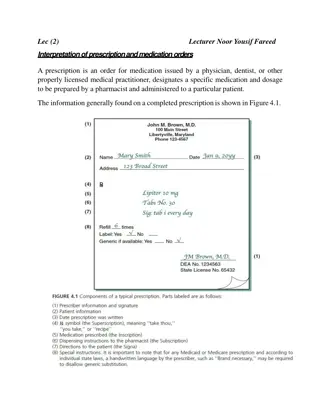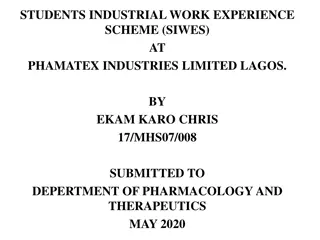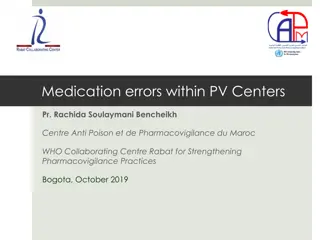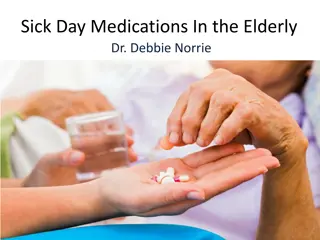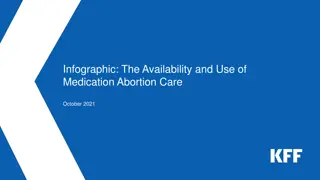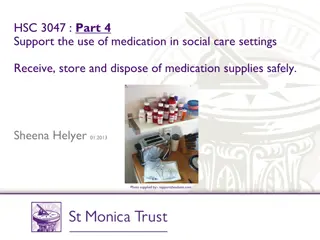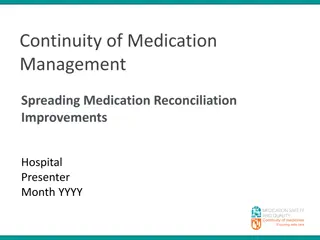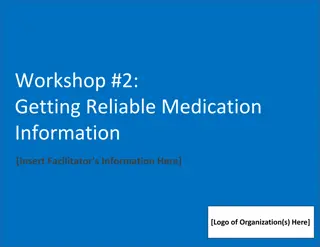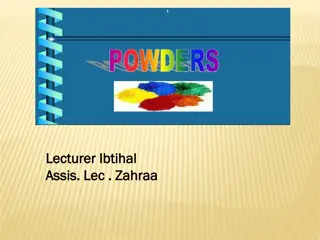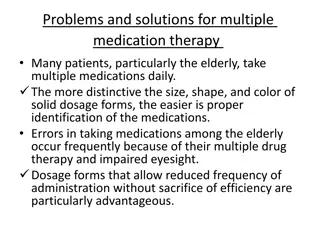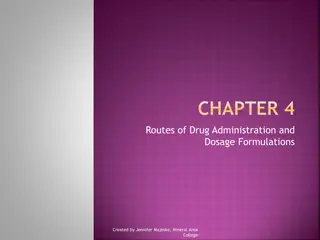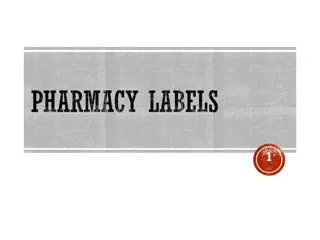Understanding Dosage Forms and Excipients in Medication Design
Dosage forms play a crucial role in the safe delivery and effectiveness of medications. They serve various purposes such as protecting drugs from environmental factors, controlling drug release, and providing different routes of administration. Excipients like flavors, colorants, and preservatives are also utilized in medication design. Capsules are often preferred over tablets for ease of swallowing, and different dosage forms are tailored based on patient age and condition.
Download Presentation

Please find below an Image/Link to download the presentation.
The content on the website is provided AS IS for your information and personal use only. It may not be sold, licensed, or shared on other websites without obtaining consent from the author. Download presentation by click this link. If you encounter any issues during the download, it is possible that the publisher has removed the file from their server.
E N D
Presentation Transcript
Besides providing the mechanism for safe and convenient delivery of accurate dosage, dosage forms are needed for additional reasons: 1- To protect drug from destructive influences of atmospheric oxygen or humidity (coated tablets, sealed ampules). 2- To protect the drug substance from destructive influence of gastric acid after oral administration (enteric-coated tablets). 3- To mask bitter, salty, or odor of a drug substance (capsules, coated tablets, flavored syrups). 4- To provide liquid preparations of drug substances, either as dispersions (suspensions) or as clear preparations (solutions).
5-To provide rate controlled drug action (controlled- release tablets, capsules, and suspensions). 6- To provide topical administration sites (ointments, creams, transdermal patches, and ophthalmic, ear, and nasal preparations). 7- To provide for insertion of a drug into body s orifices (rectal or vaginal suppositories). 8-To provide for placement of drugs directly in blood stream or body tissues (injections). 9-To provide for optimal drug action through inhalation therapy (inhalants and inhalation aerosols)
GENERAL CONCIDERATION FOR DOSAGE FORM DESIGN If drug is intended for systemic use and oral administration is desired, tablets and/or capsules are usually prepared. If drug used in emergency in patient with coma, injectable form of medication may be prepared. motion sickness, nausea, and vomiting, for which tablets and skin patches are used for prevention and suppositories and injections for treatment. The age patient plays a role in dosage form design: For infants and children younger than 5 years of age, pharmaceutical liquids are preferred for oral administration. person with difficulty in swallowing tablet can use chewable tablets or orodispersible tablets that dissolve in mouth in about 10 to 15 seconds; this allows patient to take a tablet but actually swallow a liquid.
Capsules have been found by many to be more easily swallowed than whole tablets. If a capsule is moistened in the mouth before it is swallowed, it becomes slippery and readily slides down the throat with water. Also, a teaspoonful of gelatin dessert, liquid candy, or syrup placed in the mouth and partially swallowed before placing the solid dosage form in the mouth aids in swallowing them. Medications intended for elderly are commonly formulated into oral liquids.
EXCIPIENTS flavors and sweeteners. Colorants Preservatives Antioxidants chelating agents lubricants
Not all salts are salty but their taste is function of both cation and anion. Salty tastes :NaCl, KCl, NH4Cl and by NaBr, KBr. ammonium give bitter and salty sensations. potassium iodide and magnesium sulfate (epsom salt) are predominantly bitter.
In general, low-molecular-weight salts are salty, and high-molecular-weight salts are bitter. With organic compounds, increase number of hydroxyl groups ( OH) increase the sweetness of the compound.
FLAVORING PHARMACEUTICALS Added to liquid mask taste. Chewable tablets, such as antacid and vitamin products, usually are sweetened and flavored to improve acceptance. Organic compounds: Increase number of hydroxyl groups (-OH) increase sweetness of compound. Sucrose(8 -OH), sweeter than glycerin(3-OH) In general: organic esters, alcohols, and aldehydes are pleasant to the taste volatile, affect odor and flavor of preparations
Many nitrogen-containing (e.g., quinine) bitter, but other nitrogen-containing (e.g., aspartame) are sweet. Even simple structural change alter taste. D-Glucose is sweet, but L-glucose has slightly salty. saccharin is very sweet but N-methyl-saccharin is tasteless.
Selection of appropriate flavor depends on several factors: A: Taste of drug. 1. cocoa-flavored masking bitter. 2. Fruit or citrus flavors sour or acid- tasting. 3. cinnamon, orange, raspberry, make preparations of salty drugs 4.
B: The age Children prefer sweet candy-like with fruity flavors. Adults prefer less sweet with tart flavor. soybean and oils; carriers include water, ethanol, propylene glycol, glycerin, and emulsifiers. Dry carriers include maltodextrins, corn syrup, modified starches, gum, salt, sugars, and whey protein. Flavors degrade by light, temp, oxygen, water, enzymes 1. 2. 3. Artificial flavor: Any substance used to give flavor that is not derived from spice, fruit or fruit juice, vegetable or vegetable juice, herb, bark, bud, root, leaf eggs, dairy
SWEETENING PHARMACEUTICALS saccharin excreted unchanged by kidneys. Cyclamate, is metabolized, in GIT, and excreted by kidneys. Aspartame breaks down to three basic components: amino acids phenylalanine and aspartic acid, and methanol. are metabolized through regular pathways in the body.
metabolism to phenylalanine. use of aspartame by persons with phenylketonuria (PKU) is discouraged. diet foods and drinks must bear label warning not be consumed by such individuals. They cannot metabolize phenylalanine adequately, so they undergo an increase in the serum levels of the amino acid (hyperphenylalaninemia). result in mental retardation and can affect the fetus of a pregnant woman who has PKU.
OTHER ARTEFICIAL SWEETNERS Acesulfame potassium, a non nutritive sweetener Structurally similar to saccharin, it is 130 times as sweet as sucrose and is excreted unchanged in urine. Acesulfame is more stable than aspartame at elevated temperatures use in candy, chewing gum, and instant coffee and tea. Stevia powder30 times as sweet as sucrose.used in both hot and cold preparations.
COLORING PHARMACEUTICALS sulfur (yellow), riboflavin (yellow), cupric sulfate (blue), ferrous sulfate (bluish green), cyanocobalamin (red), and red mercuric iodide (vivid red). most pharmaceutical colorants in use synthetic, a few are natural mineral and plant sources. ferric oxide mixed with zinc oxide to give calamine pink color. 0.0005% to 0.001% FD&C, D&C, dyes or lake. 30 to 60 coats:tablet dyes. With lakes, fewer color coats are used
ointments, suppositories, and ophthalmic and parenteral products assume the color of their ingredients and do not contain color additives.
PRESERVATIVES Ophthalmic and injectable preparations, sterilized by physical methods (autoclaving for 20 minutes at 15 lb pressure and 121 C, dry heat at 180 C for 1 hour, or bacterial filtration) during manufacture. syrups, emulsions, suspensions, and some semisolid creams protected by addition of antimicrobial preservative hydroalcoholic and most alcoholic preparations not require addition of preservative when the alcoholic content is sufficient to prevent microbial growth.
15% V/V alcohol will prevent microbial growth in acid media and 18% V/V in alkaline media. elixirs, spirits, and tinctures, are self- sterilizing and do not require additional preservation.
PRESERVATIVE SELECTION SHOULD prevents growth of microorganisms. Soluble in water to achieve adequate concentrations in aqueous phase. Concentration of preservative does not affect safety of patient. has adequate stability and not reduced in conc by decomposition during desired shelf life of preparation. compatible with all formulative ingredients. The preservative does not adversely affect container or closure.
GENERAL PRESERVATIVE CONSIDERATIONS intravenous preparations given in large volumes as blood replenishers or nutrients not contain bacteriostatic additives. Microorganisms molds, yeasts (acid medium).bacteria favoring slightly alkaline medium. few microorganisms grow below pH 3 or above pH 9 Aqueous preparations are within favorable pH range must be protected against microbial growth.
Preservative must dissolve in sufficient concentration in aqueous phase of preparation. , only undissociated fraction of preservative possesses preservative capability, because the ionized portion is incapable of penetrating the microorganism. preservative selected must be largely undissociated at pH of the formulation prepared.
Acidic preservatives benzoic, boric, and sorbic acids more undissociated more effective as the medium is made more acid. Conversely, alkaline preservatives are less effective in acid or neutral media and more effective in alkaline media. if formula interfere with solubility or availability of preservative t, its chemical conc may misleading, because it may not be a true measure of the effective concentration.
tragacanth, attract and hold preservative, such as the parabens and phenolic rendering them unavailable for preservative function. preservative must not interact with container, such as a metal ointment tube or a plastic medication bottle, or closure, such as a rubber or plastic cap or liner.
MODE OF ACTION OF PRESERVATIVES Modification of cell membrane permeability. Lysis and cytoplasmic leakage Irreversible coagulation of cytoplasmic constituents (e.g., protein precipitation) Inhibition of cellular metabolism, such as by interfering with enzyme systems or inhibition of cell wall synthesis Oxidation of cellular constituents Hydrolysis 1. 2. 3. 4. 5.
PRESERVATIVES CONCENTRATIONS benzoic acid (0.1% to 0.2%). sodium benzoate (0.1% to 0.2%) alcohol (15% to 20%), phenol (0.1% to 0.5%), cresol (0.1% to 0.5%), benzalkonium chloride (0.002% to 0.01%) combinations of methylparaben and propylparaben (0.1% to 0.2)against fungus.
Preservative in ophthalmic preparation must have low degree of irritant qualities, like chlorobutanol, benzalkonium chloride.


